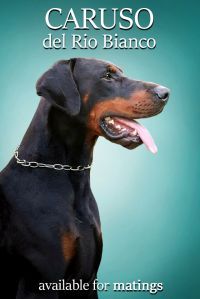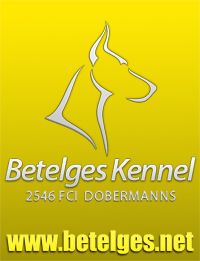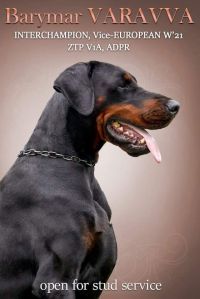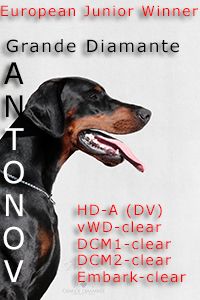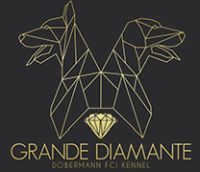Autori:
Dr. Massimo Massa
Giudice specialista Dobermann
DVM dottore in medicina veterinaria
Allevatore – Dobermann Kennel Dell'Urbe – dal 1970
Dr. Angelo Magnifico
Giudice specialista Dobermann
DVM dottore in medicina veterinaria
Allevatore – Dobermann Kennel del Canale di Pirro – dal 1973
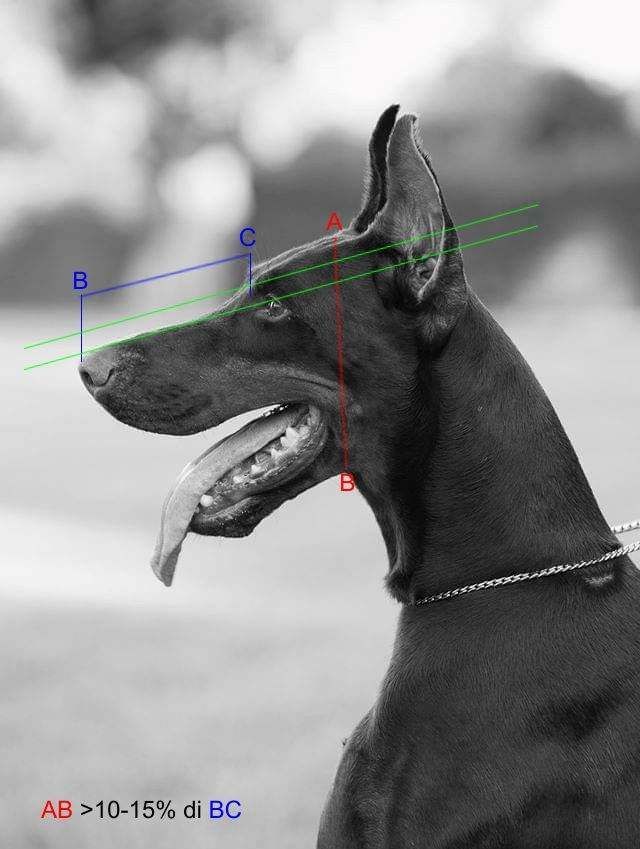
This short text is a result of many discussions and exchange of views I observed last years between dobermann experts and some new-comers.
Their friendly technical comparisons allowed me to understand that recently some kind of confusion was born on what the dobermann head should be and what shouldn't. It's not my intention to dive deeply into philosophy, I simply believe that specific dualism was created in the way of thinking, sort of internally contrary rule that divides two groups which remain opposite to each other and represent different views on dobermann head.
Cynology is not a scientific subject and shouldn't be as scource to generate dualisms. It is based on clearly defined parameters and characterstics described in breeds standard. Its purpose [standard] was to navigate us and show directions how to develop the breed same as axles of dobermann cranium or railways to lead us into only one and precise goal. Too often we witness in social media photos of dobermann heads which are absolutelly out of type (untypical) but they gain plenty of likes and positive reactions. Such dogs in some european countries incomprehensibly receive awards at dog-shows and other competitions but in fact they have a very small amount of dobermann features [typicity]. What's more, I dare to say that they possess features of other breeds.
As popular defects the following can be mentioned: unparallel lines of head or even opposite, over-massive upper-jaws which are typical for moloses, round skulls, wrinkles on foreheads, thick and free lips, thick skin, round and deeply settled eyes without typical breed expression. It all together trully shocks me and makes me feel like we are in the center of the process where the breed is moving out from its nature and turns into different breed. I find it necessary to take a voice on this issue and along with Dr. Massimo Massa, FCI judge, breed specialist and breeder with 50 years of experience, we came on idea for this article.
The main purpose is to give technical tips for those who were unlucky or due to their age had no chance to discover typical dobermanns.
To have a future, there has to be strong foundation for growth. We can't understand the breed as it is today without looking at possitive aspects of dogs from von Furstenfeld, von Forell, von Franckenhorst, von Hagenstern, von Norden Stamm and other kennels. I do believe that all new-comers of our breed should read and study the history of the breed with strong emphasis on cynological aspects [typicity]. There is no future to develop the breed without respect of cynological culture. Definitely, there's a need to get things in order and remind about essential technical head parameters to find directions and commonly accepted rule on how the dobermann head should look like.
Features and main parameters of Dobermann dog’s head:
Main features constitute the main breed indicator.
Dobermann’s head is characterised by dolichocephaly, which means that its bizygomatic width must be smaller than the half of the total length of head. In other words – it must be narrow and elongated.
Vista dall'alto, la testa ha la forma di un cono tronco e allungato.
As seen from above, head is of shape of an elongated frustum of a cone.
The skull-snout ratio is 1:1; that is, the skull and the snout are of the same length. These two macro-body parts (skull and snout) are divided with a horizontal line which connects the medial palpebral commissures, which is the line which connects the inner corners of eyes.
In comparison with profiles, Dobermann’s head is rectilinear.
Axis of the facial skeleton are parallel.
Those two axes never touch.
The lower axis fallows the upper profile of the nasal septum, from the tip of the nose up to the perfect straight line which connects the inner corners of eyes. The upper axis is derived from the hypothetical extended line which connects two specific anatomical orientation points:
The nasion and inion craniometric points.
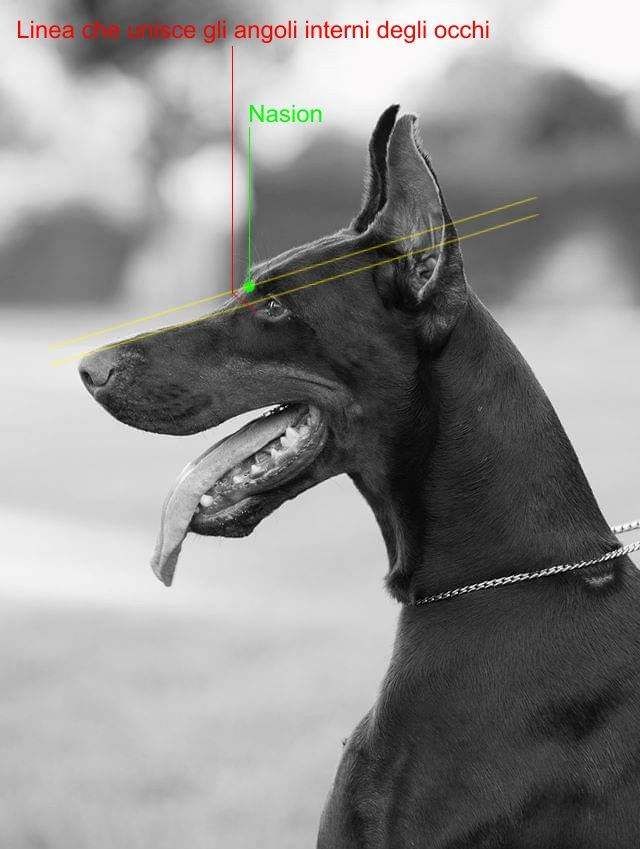
The nasion craniometric point is a point of contact of the apophysis of nose bones and the upper and frontal jaw bones.
This Dobermann’s craniometric point is anatomically located approximately in the middle of height of the nose-forehead edge and it is places above the line which connects the medial eye corners.
However; unfortunately, in some of the publications on the topic of cynophilia [philia = a suffix in compounds which indicates semantical reference to love, sympathy, liking; gr. kynós = dog] and cynognostics, one may read, that the nasion is located in the middle of the perfect straight line which connects the internal eye corners.
This is impossible due to the fact, that if that was the case, all Dobermans would be convergent!
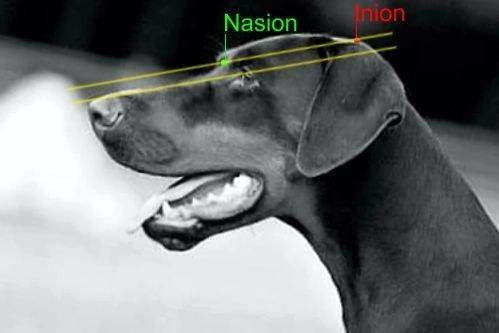
The inion craniometric point corresponds with the centre of the occipital squama.
We would like to remind, that defects of facial skeleton axis, i.e. divergence or convergence, are considered significant breed defects in Dobermanns, which should be clearly punished during zootechnical events.
Another important cynognostic parameter is the nose-forehead edge which is located in the gap between the two upper head lines, i.e. the nasal septum profile and the skull upper profile. It must be evident but never excessively evident. The standard indicates: the nose-forehead edge must be non-significantly developed but perfectly felt. Too often we can see excessive nose-forehead edges, steps, or on the contrary, disappearing nose-forehead edges, almost impossible to feel, which significantly diverge from the description within the standard.
The nasal septum must be rectilinear, wide, but proportional to the rest of the head.
Dog’s nose must be well developed [large], wide, black in case of black-fiery specimens and dark-brown in case of brown-fiery specimens.
The nostrils must be clearly opened. The snout must be long, full and well modelled, it must be characterised with a proper mass; however; it can never be excessively strong [excessively well developed, large]. It must be harmonious and proportional to the rest of the head. The lateral surfaces of the snout must coincide in a moderate manner toward the nose. The front of the snout must be flat and never pointy.
The lower jaw must be long and proportionately wide so that it enables the snout to be fully and harmoniously large. In the front, it must reach the jaw in a manner that enables the incisors to precisely adhere to each other and to render the proper enclosing in shape of scissors. Specimens with deep lower jaws are almost always characterised with a proper enclosing in shape of scissors. 42 teeth must be white, firm, properly arranged in a row and they must enclose like scissors.
The lips are stretched and strongly pigmented. Doberman’s dark pigmentation is valued
and it is considered an advantage. Very often, specimens with intensive-black colour of fur with dark lips and strongly pigmented eyelid rims have also dark eyes. The labial commissure must be clearly visible but never excessively. Position of the commissure must be as aboral as possible, i.e. with a long aperture limited with lips [dog must have a long mouth aperture]. It must reach at least a position in line with the eye level; the better if it reaches further.
The skull, as seen from a side or frontally, is flat. The horizontal occipital line, as seen frontally, must be horizontal, so the external occipital convexity cannot be excessively visible.
The frontoparietal muscles must be visible but not well developed.
In the frontal region, the frontal suture must be visible but not excessively clear. The brow bridges are clearly visible but not excessively protruding. No frontal tubers are acceptable in adult Dobermanns; however, they are acceptable in case of still developing pups during skull bones development period.
A breed distinctive feature is carving [chisel] [translators note – in the source text the word „cesello" is used, which the only dictionary meaning is “chisel”; it is possible that in the vet/breeder jargon this word has a different meaning], which is considered an advantage regarding the suborbital region. A perfect carving [chisel] occurs when the skin is delicate, the level of development of the subcutaneous tissue and the muscles below it is non-significant enough to enable the bone bulges to be visually perceived. If the suborbital region is not well carved, in cynognostics, the expressions “compressed head” or “compressed carving [chisel]” are used.
The length of the skull or the bridge – a very important cynotechnical parameter, almost never taken into consideration by cynognostics specialists, is the height of head. The anatomical orientation points for purpose of assessment of this parameter are: the point which stretches from the upper skull profile close to the medial ear cartilage attachment and the lower jaw angle process. This zoognostic parameter can be assessed by prolonging the vertical line which connects the above-mentioned anatomical orientation points. A proper cynognostic tool for this measurement is a calliper compass or a vernier, but an experienced judge may asses it visually with no problems. Height of head should not exceed 10 -15 % of half of the total length of the head. Therefore, a specimen with a 30 cm long head will have a 15 cm long skull and nasal septum.
Height of the head will be 17,25 centimetres maximal; that is, 15% longer than the nasal length. A significantly high head will render itself less harmonious; it is stockier and in shape of a parallelepiped, not in the shape of a frustum of a cone, as required by the standard.
Doberman’s eye is of medium size and oval shape. Its position must be semi-lateral, with an angle of 15 – 25% of the angle between the line which connects the two eyelid corners and the medial surface. Both the iris and the pupil must be of a colour as dark as possible; of curse, in a proper relation to the fur colour tone. The eyes must not be too protruding or sunken. Both the eyelids and the nictitating membrane must be strongly pigmented, best if of the same colour as the fur.
Dobermann's ear should be integral and of triangular shape, its cartilages should be flat and thin, never curled. Their length should not touch the lips.
I hope this short text was helpful and clear to understand the whole issue about dobermann head.
Dr. Angelo Magnifico
Along with my friend - Angelo Magnifico, we are both judges and breed specialists. We consider it as necessity to specify the present selection of dobermann head. There is no doubt that head is one critical part of dog's anatomy which represent identity of certain breed. Unfortunatelly, we observe many heads very poor in type but by some they are considered as attractive. In comparison to other parts of dog's anatomy it is very difficult to work on proper heads as there is a large number of parameters to taken care of such as relation of skull-muzzel, parallelism, stop, length and volume [substance] of upper jaw and under jaw, shape, eye, expression...
Dr. Massimo Massa
Post Scriptum:
We wish to add photos and descriptions to this article which with some other parts were presented in the full version but it was impossible.
We would like to emphasize that it was not of our interest to harm the image of any dog or breeder. We have chosen the photos randomly and freely from those available in the internet web.
Purposely we removed from photos any data such as dog's, breeder's or owner's names not to cause any harm.
The photos were used only to express the subject better and to make it more understandable. Doing this we wanted to carry a small contribution to the breed trying to give directions on how the dobermann head should look like according to breed standard.
We couldn't restrain ourselves from some commments as the subject we wrote about would not be easy to understand.
The article was written entirely by undersigned without help of any third party. It's a result of free thought of two dobermann enthusiats who represent the old generation.
We wish you a peaceful summer !
Viva Dobermann !
Angelo Magnifico - Massimo Massa














